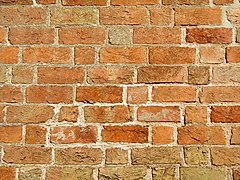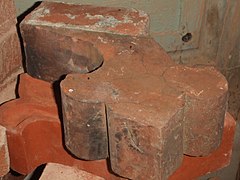Brick Gothic
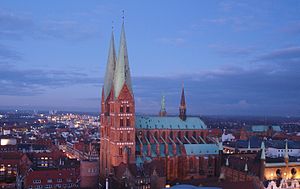

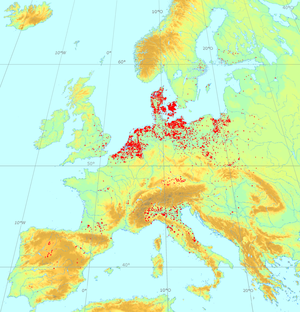
Brick Gothic (
.As the use of baked
Brick Gothic is characterised by the lack of figurative
The real extent and the real variety of this brick architecture is yet to be fully distinguished from the views published in the late 19th and early 20th century, especially the years around the end of World War I, when the style was politically instrumentalized.[clarification needed]
Indeed, about a quarter of medieval Gothic brick architecture is standing in the Netherlands, in Flanders and in French Flanders. Some of these buildings are in a combination of brick and stone. The towers of St Mary's church in Lübeck, the most significant Brick Gothic church of the Baltic Sea region, have corners of granite ashlar. Many village churches in northern Germany and Poland have a Brick Gothic design despite the main constituent of their walls being boulders.
Brick Gothic architecture

In contrast to other styles, the definition of Brick Gothic is based on the material (brick), and a geographical area (countries around the Baltic Sea). In addition, there are more remote regions with brick buildings bearing characteristics of this architectural style further south, east and west—these include Bavaria, and western Ukraine and Belarus, along with eastern England and the southern tip of Norway.
Historical conditions
In the course of the medieval German
The newly founded cities soon joined the
In the regions along the southern coast of the Baltic Sea, the use of brick arrived almost at the same time as the art of masonry. But in Denmark, especially Jutland, in the Frisian regions, in present-day Netherlands and in the Lower Rhine region, many high-quality medieval stone buildings were built before the first medieval brick was burnt there. Nevertheless, these regions eventually developed a density of Gothic brick architecture as high as in the regions near the southern coast of the Baltic Sea. The central and southern regions of Poland also had some important early stone buildings, especially the famous round churches. Many of these buildings were later enlarged or replaced using brick in a Gothic style. Especially in Flanders, the Netherlands, the lower Rhine region, Lesser Poland and Upper Silesia, Brick Gothic buildings often, but not alway, have some elements of stone ashlar. In the Netherlands it was mostly tufa, in Denmark old squared granite and new limestone. On the other hand, in many regions regarded as typical for Brick Gothic, boulders were cheaper than brick, and therefore many buildings were erected using boulders, and only decorated by brick, all through the period of Gothic architecture.
Development
Brick building became prevalent in the 12th century, still within the
The techniques of building and decorating in bricks were imported from Lombardy. Also some decorative forms of Lombard architecture were adopted.[1]
In the areas dominated by the
In the Margraviate of Brandenburg, the lack of natural stone and the distance to the Baltic Sea (which, like the rivers, could be used for transporting heavy loads) made the need for alternative materials more pressing. Brick architecture here started with the Cathedral of Brandenburg, begun in 1165 under Albert the Bear. Jerichow Monastery (then a part of the Archbishopric of Magdeburg), where construction started as early as 1149, was a key influence on Brick Gothic in Brandenburg.
Characteristics

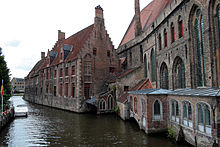
Romanesque brick architecture remained closely connected with contemporary stone architecture and often simply translated the latter's style and repertoire into the new material. The decorative techniques to suit the new material were imported form northern Italy, where they had been developed as part of the Lombard Style. Among these techniques was the use of moulded brick to realize delicate ornament. Brick Gothic drew on Romanesque building (in stone and in brick) of its region, but in its core area Romanesque stone buildings were rare and often humble In character.
In most regions of Brick Gothic, boulders were available and cheaper than brick. In some regions, cut stone was available as well. Therefore, besides all-brick buildings, there are buildings begun in stone and completed using brick, or built of boulders and decorated with brick, or built of brick and decorated with cut stone, for instance in Lesser Poland and Silesia.
Brick Gothic buildings are often of monumental size, but simple as regards their external appearance, lacking the delicacy of areas further south, but this is not exclusively the case.
None of these buildings is exactly the same today as in the Middle Ages. For instance, many of them have had alterations in a Baroque style and have then been re-gothicized in the 19th century (or reconstructed after World War II). Especially in the 19th century, some buildings were purified during restoration.[2] In the city halls of Lübeck and Stralsund, medieval window framings of stone were replaced by new ones of brick.
At a time when ordinary people lived very locally based lives, the groups responsible for these buildings were internationally mobile: the bishops, abbots, aristocrats, and long-distance merchants who commissioned the work, and the highly skilled specialist craftsmen who carried it out. For this reason the Brick Gothic of the countries around the Baltic Sea was strongly influenced by the cathedrals of France and by the gothique tournaisien or Scheldt Gothic of the County of Flanders (where also some important Brick Gothic was erected).
One typical expression of the structure of walls, the contrast of prominent visible brick with the plastering of recessed areas, had already been developed in Italy, but became prevalent in the Baltic region.
Brick as the basic material
Since the bricks used were made of clay, available in copious quantities in the Northern German Plain, they quickly became the normal replacement for building stone. The so-called monastic format became the standard for bricks used in representative buildings. Its bricks measure circa 28 x 15 x 9 cm to 30 x 14 x 10 cm, with mortar joints of about 1.5 cm. In contrast to hewn-stone Gothic, the bricks and shaped bricks were not produced locally by lodges (Bauhütten), but by specialised enterprises off-site.
-
Brick wall in "Gothic bonding"
-
Shaped brick
-
Glazed brick
-
Black-glazed shaped brick
Elements
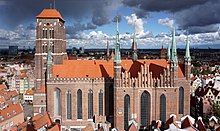
The use of shaped bricks for tracery and friezes also can be found in some buildings of northwestern Gothic brick architecture. Masterly use of these elements is found in some of the Gothic buildings of northern Italy, where these highly sophisticated techniques had originally come from, having been developed in the
While in central northern Germany and in Greater Poland suitable natural building stone was unavailable, trading cities could import it by sea. Therefore, St. Mary's Church in Lübeck, generally considered the principal example of Brick Gothic, has two portals made of sandstone, and the edges of its huge towers are built of ashlars, as normal for Gothic brick buildings in the Netherlands and the (German) Lower Rhine region. And the very slim pillars of its Briefkapelle (letters chapel) are of granite from Bornholm.[3] In the Gothic brick towers of the churches of
Germany
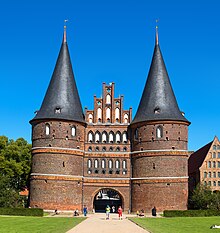
Brick architecture is found primarily in areas that lack sufficient natural supplies of
In the northwest, especially along Weser and Elbe, sandstone from the mountains of Central Germany could be transported with relative ease. This resulted in a synthesis of the styles from east of the Elbe with the architectural traditions of the Rhineland. Here, bricks were mainly used for wall areas, while sandstone was employed for plastic detail. Since the brick has no aesthetic function per se in this style, most of the northwest German structures are not part of Brick Gothic proper. The Gothic brick buildings near the Lower Rhine have more in common with the Dutch Gothic than with the northern German one.
Bavarian Brick Gothic
In Bavaria, there is a significant number of Gothic brick buildings, some in places without quarries, like
Poland

Brick Gothic in Poland is sometimes described as belonging to the
Brick Gothic in Pomerania
Much of the coast of the
France
Northern France

Even the Westhoek region in the very north of France, situated between Belgium and the Strait of Dover has instances of northern Brick Gothic, with a high density of specific buildings.[clarification needed] For example, there is a strong similarity between the Belfry of Dunkirk and the tower of St Mary's Church in Gdańsk.
Southern French Gothic
Southern French Gothic is a specific style of
Gothic Revival – 19th-century Neo-gothic

In the 19th century, the Gothic Revival—Neogothic style led to a revival of Brick Gothic designs. 19th-century Brick Gothic "Revival" churches can be found throughout Northern Germany, Scandinavia, Poland, Lithuania, Finland, the Netherlands, Russia, Britain and the United States.
Important churches in this style included St Chad's Cathedral, Birmingham (1841) by Augustus Pugin, the 1897 Mikkeli Cathedral in Mikkeli in Finland, and St. Joseph's Church in Kraków, Poland is a late example of the revival style.
See also
- List of Gothic brick buildings
- European Route of Brick Gothic
- Gothic architecture in modern Poland
- Gothic architecture in Lithuania
- Belarusian Gothic
- List of Brick Romanesque buildings
- List of Brick Renaissance buildings
Notes and references
- ^ Otto Stiel, Hans Wentzel. "Backsteinbau". Reallexikon der deutschen Kunstgeschichte. pp. 1345–1372.
- ^ Jens Christian Holst, Die Rathausfront in Stralsund – zu ihrer Datierung und ersten Gestalt (in Matthias Müller (Hg.) Multiplicatio et variatio: Beiträge zur Kunst : Festgabe für Ernst Badstübner zum 65. Geburtstag, Lukas Verlag 1998, S. 60 ff.)
- ^ "Archived Document". Archived from the original on 18 January 2016. Retrieved 18 January 2016.
- Hans Josef Böker: Die mittelalterliche Backsteinarchitektur Norddeutschlands. Darmstadt 1988. ISBN 3-534-02510-5
- Gottfried Kiesow: Wege zur Backsteingotik. Eine Einführung. Monumente-Publikationen der Deutschen Stiftung Denkmalschutz, Bonn 2003, ISBN 3-936942-34-X
- Angela Pfotenhauer, Florian Monheim, Carola Nathan: Backsteingotik. Monumente-Edition. Monumente-Publikation der Deutschen Stiftung Denkmalschutz, Bonn 2000, ISBN 3-935208-00-6
- Fritz Gottlob: Formenlehre der Norddeutschen Backsteingotik: Ein Beitrag zur Neogotik um 1900. 1907. Reprint of 2nd ed., Verlag Ludwig, 1999, ISBN 3-9805480-8-2
- Gerlinde Thalheim (ed.) et al.: Gebrannte Größe – Wege zur Backsteingotik. 5 Vols. Monumente-Publikation der Deutschen Stiftung Denkmalschutz, Bonn, Gesamtausgabe aller 5 Bände unter ISBN 3-936942-22-6
- B. Busjan, G. Kiesow: Wismar: Bauten der Macht – Eine Kirchenbaustelle im Mittelalter. Monumente Publikationen der Deutschen Stiftung Denkmalschutz, 2002, ISBN 3-935208-12-X)
External links
- RDK-Labor: digitized text of Reallexikon zur Deutschen Kunstgeschichte (1937), Backsteinbau by Otto Stiehl (chapters I–III) and Hans Wentzel (chapters IV–VI)
- European Brick Gothic Route
- Exhibition Wege zur Backsteingotik 2002–2005
- Permanent exhibition Wege zur Backsteingotik, Wismar Archived 5 March 2016 at the Wayback Machine

